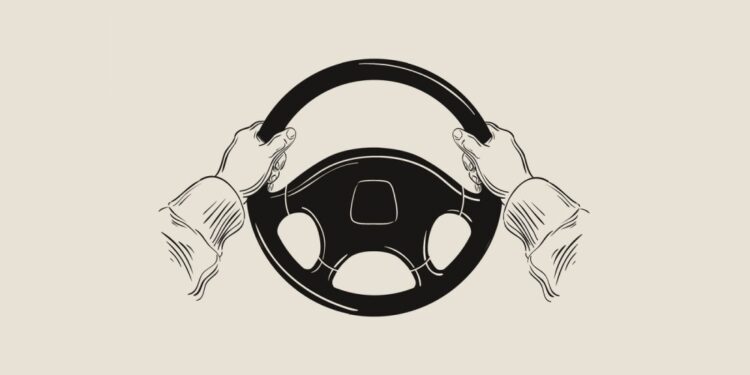Properly holding the steering wheel is an important safety precaution to observe every time you are driving. The wheel controls your entire vehicle after all. Drivers who use the correct technique to hold the steering wheel of their vehicle are less likely to have an accident and will be able to use their vehicle more efficiently. Statistics show that improper steering wheel techniques are the main cause of crashes when drivers run off the road.
Proper steering wheel hand position
At some point you might have heard the phrase “10 and 2” when it comes to where to put your hands on the steering wheel. These numbers are in reference to a clock. Your hands should be where the “10” and “2” numbers would be. However, the technique for proper placement of your hands on the steering wheel has changed dramatically over the years. Now, the recommended technique is known as “9 and 3”.
Place your left hand on the left portion of the steering wheel in a location approximate to where the nine would be if the wheel was a clock. Your right hand should be placed on the right portion of the wheel where the three would be located. These recommendations are quite flexible, but keep in mind that 10 and 2 o’clock is no longer recommended because it can be dangerous in vehicles with smaller steering wheels and equipped with airbags.
Since steering wheel sizes vary, review your vehicle’s owner’s manual to decide the hand position that works best for your car. Generally, many people feel that their arms are comfortably aligned with their shoulders in the “9 and 3” position. This technique keeps your hands in the proper position to use the “push and pull” method of turning the steering wheel. Additional steering wheel hand position recommendations include:
- Place both hands on the outside of the steering wheel on opposite sides.
- Maintain a firm-but-gentle grip on the wheel.
- Use your fingers to control the wheel rather than your palms. Keep your thumbs up along the steering wheel’s face.
- Don’t turn the wheel when you’re gripping it from the inside of its rim.
Select the proper steering method for a given situation
Your steering wheel technique is perhaps most important when turning your vehicle. There are three standard steering methods that should be used when you’re turning your car.
a. Hand-to-hand steering
This method, also known as push/pull steering, requires you to move your left hand between the “7 and 8 o’clock” position and your right hand between “4 and 5 o’clock”. Your right or left hand pushes the steering wheel up, while the opposite hand slides up, grabs the wheel and pulls it down to turn. While the pulling hand moves down, the hand that first pushed up moves back to its original position to make any necessary adjustments.
The driver should use the area of the steering wheel area between “11 and 8 o’clock” with their left and the “1 and 8 o’clock” area with their right, regardless of which way they’re turning. Using the hand-to-hand or push/pull steering method helps prevent injuries. Your hands do not cross over the steering wheel with this method, which decreases the chance of your hands or arms hitting and injuring you in the event of an airbag deployment.
b. Hand-over-hand steering
The hand-over-hand steering method is best when you are turning at low speeds, have limited visibility at an intersection or parking. It’s also helpful if you run into a skid. Put your left hand between the “8 and 9 o’clock” part of the wheel and your right between the “3 and 4 o’clock” position to steer hand-over-hand. You can use the right top third of your steering wheel to move it in that direction.
Do the opposite to move the wheel to the left. As far as wheel movement, your right or left hand takes the wheel and pushes up, while the other hand releases, moves across the opposite arm and pulls wheel up – hence the term, “hand-over-hand”. When the steering wheel is pulled up, the hand that started the push releases and goes back to its original position.
c. One-handed steering
It’s best to keep two hands on the wheel as often as you can. There will be times when you need to steer with one hand, however. This could occur when you need to turn on your headlights, windshield wipers or turn signal. You’ll also need to master the one-handed steering technique to shift gears in a vehicle with manual transmission. In these instances, keep the other hand at the “8-9 o’clock” or “3-4 o’clock” position.
Doing so will keep your car steady and keep you in a position to make more steering moves if necessary. Only use the “12 o’clock” steering position when you have to reverse your vehicle out of a space and to turn in your seat to see where you’re going. Get into the habit of looking back even if you have camera-assisted backup.
Don’t forget about proper posture and positioning
Holding your steering wheel properly increases the likelihood of a safe drive. While the wheel is important to driver safety, it’s only as effective as the rest of your surroundings. Even experienced drivers should be conscious of their posture, body position, and hand placement while driving. Make sure your headrest, seat and mirrors are adjusted property to match your height.
You should also be able to adjust your steering wheel position, depending on the vehicle model. Make all of these adjustments before you hit the road. Most models of cars allow drivers to move the steering column up or down by using a lever or handle located underneath the steering wheel. Some models also allow drivers to pull the wheel towards them or push it closer to the dashboard.
Take a few moments to ensure that all of the vehicle’s available adjustments are customized so that you are in a comfortable position before you begin to drive. You should be able to clearly see both side mirrors and the rearview mirror, rotate from side to side to check your blind spots, and have an unobstructed view through the windshield without having to crane your neck. Save your head turning for when you need to check your blind spots before changing lanes.
Good posture can also make for a safer and more comfortable drive. Move your tailbone to as close to your seatback as possible for better back support. Don’t sit too close to your steering wheel. You want to be close enough to reach the pedals and be able to push them with your whole foot, but not so close that you risk injuring your head, neck or chest in a collision.
Final thoughts
As you steer your vehicle, you should never take either of your hands off of the steering wheel. The “push and pull” method of turning the steering wheel allows you to safely rotate the steering wheel while keeping both hands in contact. For example, if you are turning to the right, you will push the steering wheel in a clockwise motion with your left hand while simultaneously pulling the wheel in a clockwise motion with your right hand.
Some drivers simply push the wheel with the hand opposite of the direction in which they are turning while allowing the other side of the wheel to slide through the loose grasp of the other hand. It is not acceptable to turn your steering wheel with only the palm of one hand or with your thumbs. The “push and pull” method should be used for every turn, every time you drive. Proper placement of your hands on the steering wheel is essential to driving your vehicle safely.
Remember to place your hands in the “9 and 3” position at all times while driving. Never drive with only one hand, your fingertips, or, even worse, with your knees. While turning to the left or right, use the “push and pull” technique to ensure that the steering wheel does not slip out of your hands. Not only will proper placement of your hands on your vehicle’s steering wheel help you pass your driving exam, it will also contribute to your overall safety while on the road.




































































































































































































